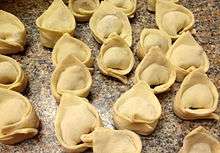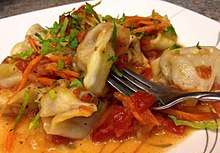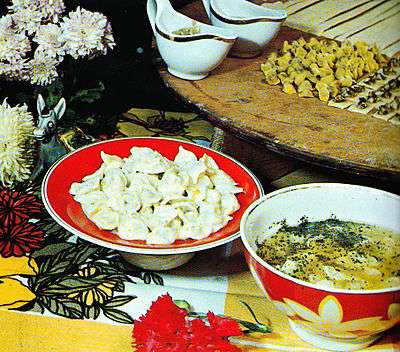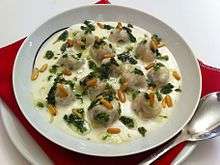Joshpara
Joshpara is a kind of dumpling popular in Central Asia, Caucasus and the Middle East.[1]
 Joshpara prepared for cooking | |
| Alternative names | chuchvara, chüchüre, chüchpara, düshbärä, shishbarak, shushbarak, tatarbari, tushbera, tushpara |
|---|---|
| Type | Dumpling |
| Place of origin | Middle East, Central Asia |
| Serving temperature | Hot or cold |
| Main ingredients | Dough (flour, eggs, water, salt), ground meat (other than pork), onions, herbs, salt, black pepper |
Etymology
Josh means "to boil" while para is a term for "bit".[1] This word was commonly used prior to the 10th century, when it was replaced by the modern Persian name gosh e-barreh, meaning "lamb's ear". There are several variations of the name in other languages including Azerbaijani (düşbərə, dushbara), Kazakh (тұшпара, tushpara), Kyrgyz (чүчпара, chuchpara), Tajik (тушбера, tushbera), Uzbek (chuchvara) and Uyghur (چۆچۈرە, chöchürä).[1] The Arabic word shishbarak is thought to be derived from joshpara in pre-Islamic times.[1][2]
A theory about the words' etymology is that the word comes from the Turkic word düşbərə. The words tosh and dash mean "filled up" and "spill out", and berek means "food" (dishes made from dough). This alludes to the fact that düşbərə should be added in when the water is boiling and spilling out of the saucepan.[3]
A common joke suggests that the word comes from “düş bəri”, which means "fall here": in other words, asking to fill the spoon with as many dumplings as possible.[3]
Finno-Ugric peoples in Western Siberia were exposed to the dish by Iranian merchants during the Middle Ages and named it pelnan, meaning "ear bread". It was adopted in Russia in the 17th century, where the dish is referred to as pelmeni. In modern times, chicken broth is often used as a substitute for the yogurt broth.[1]
Regional variations
Turkic and Persian cuisines


Düşbərə in particular is a traditional Azerbaijani dish of dumplings made of dough and filled with ground meat and condiments.[4][5] An identical dish is also found in Iranian, Tajik, Uzbek, Uyghur, and other Central Asian cuisines.
Made of unleavened dough squares filled with meat, düşbərə type is similar to Russian pelmeni and Chinese wonton. However, in observance of the Islamic dietary rules, the meat filling is often without pork. Typical ingredients include flour, meat, onions, herbs, salt, black pepper and tomatoes. The dough for chuchvara is made with flour, eggs, water, and salt, which is rolled into a thin layer, and cut into squares. A dollop of meat filling, seasoned with chopped onions, pepper, salt and thyme, is placed at the center of each square, and the corners of the dumpling are pinched and folded. Chuchvara is boiled in meat broth until the dumplings rise to the surface. Chuchvara can be served in a clear soup or its own, with either vinegar or sauce based on finely chopped greens, tomatoes and hot peppers. Another popular way of serving chuchvara is to top the dumplings with syuzma (strained qatiq) or with smetana (sour cream). This is known as Russian-style.
In Azerbaijan, the dumplings are smaller and the dough is thicker.[6] The dumplings are typically made from dough (wheat flour, egg, water), mutton (boneless), onions, vinegar, dried mint, pepper, and salt. The dish is prepared either with water or meat broth. Mutton can be substituted with beef, or even with chicken.[3] The broth is made from mutton bones, and the ground meat is prepared with onions and spices. The dough is then rolled, cut into small squares, and stuffed with ground meat. The squares are wrapped like triangles and the edges are pasted together, making shell-shaped figures. Düşbərə is added into the boiling salty water and is cooked until the dumplings come to the surface.[3][7] Düşbərə is served with sprinkled dried mint. Vinegar mixed with shredded garlic is added or served separately to taste.[3] One tablespoon typically contains 5-8 düşbərəs, however in rural areas of Absheron, cooks might use as many as 20.[3]
Arab cuisines

The dish is known as shishbarak (Arabic: شيشبرك) or shushbarak (Arabic: شُشْبَرَك) in Iraq, Jordan, Lebanon, Palestine, Syria, Hejaz, and the northern area of Saudi Arabia. In Iraq it is also called tatarbari.[8] After being stuffed with ground beef and spices, thin wheat dough parcels are cooked in yogurt and served hot in their sauce.[9] A part of Arab cuisine for centuries, a recipe for shushbarak appears in the 15th century Arabic cookbook from Damascus, Kitab al-tibakha.[2]
See also
- Manti (dumpling)
- List of dumplings
- List of stuffed dishes
Notes
- Alan Davidson (2014). The Oxford Companion to Food. Oxford University Press. p. 434. ISBN 9780199677337.
- Uvezian, 2001, p. 261.
- Ministry of Culture and Tourism Republic of Azerbaijan (2013). Teymur Karimli; Emil Karimov; Afag Ramazanova (eds.). Azerbaijani Cuisine (A Collection of Recipes of Azerbaijani Meals, Snacks and Drinks) (PDF). Baku: INDIGO print house. p. 93. ISBN 978-9952-486-00-1.
- Once in a Lifetime Journey. "The Best Azerbaijan Food".
- Dushbara
- Once in a Lifetime Journey. "The Best Azerbaijan Food".
- Ahmedov, Ahmed-Jabir (1986). Azərbaycan kulinariyası, Азербайджанская кулинария, Azerbaijan Cookery - cookbook, in Azeri, Russian & English. Baku: Ishig. p. 40.
- Kummer et al., 2007, p. 215.
- Basan and Basan, 2006, p. 42.
References
- Basan, Ghillie; Basan, Jonathan (2006), The Middle Eastern Kitchen: A Book of Essential Ingredients with Over 150 Authentic Recipes, Hippocrene Books, ISBN 9780781811903
- Kummer, Corby (INT) (2007), 1,001 Foods to Die For, Madison Books, Andrews McMeel Publishing, LLC, ISBN 9780740770432
- Uvezian, Sonia (2001), Recipes and remembrances from an Eastern Mediterranean kitchen: a culinary journey through Syria, Lebanon, and Jordan (illustrated ed.), Siamanto Press, ISBN 9780970971685
External links
- Azerbaijan National Culinary Centre
- AZ Cookbook
- Chuchvara on pelemeni.ru (in Russian). See English translation here
- Chuchvara in Uzbek cuisine (with a photograph)